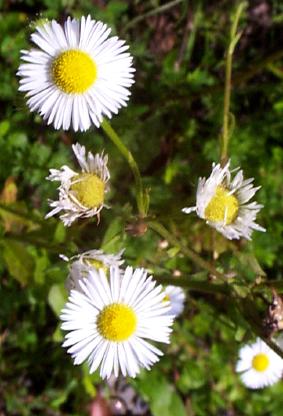|

|
HOME
Botanical
Terms
 Lists:
Master Plant
List
Flowering Times
List
Flowers by
Color/Type
Endangered
Species List
Habitat
List
Lists:
Master Plant
List
Flowering Times
List
Flowers by
Color/Type
Endangered
Species List
Habitat
List
Use the 'back' button on your browser to return, if
necessary.
|
|
 We have several
species of Aster, but this is the picture i
chose.
We have several
species of Aster, but this is the picture i
chose.
|
FAMILY:
Sunflower Family (Asteraceae)
DESCRIPTION:
Gangly plant with stiff stalks and leafy
branches, each one terminating in at least one
flower (1/2" - 3/4" across). Usually white rays,
but sometimes a pale lavender. The central disk is
yellow to brown. The leaves are narrow lance-shaped
affairs with an irregular margin. The leaves on the
branches are smaller than the main stalk.
FLOWERS:
Late July to October
HABITAT:
Sandy or marshy soil with lots of
sunlight. Open meadows and roadsides.
|
|
OTHER
INFORMATION:
The asters, like the goldenrods,
daisies, bonesets, and several other types, are
composite flowers. This means that rather than one
flower, the central disk is composed of many tiny
small flowers each with their own pistil and
stamen. Get a magnifying glass and you'll be
surprised to see what looks like hundreds of
flowers compacted together on the head. Notice too,
that an individual flower will have 'rings' of
mature flowers so that not all of these many tiny
flowers are producing nectar (or pollen) at the
same time. A bee will spend a good deal of time
probing it, and then moving on to the next flower,
going for the 'good stuff'.
The rays of a composite (what we call the
petals) are the second type of flower. This way a
visiting bee can cross-polinate literally thousands
of flowers by visiting one many-headed plant. Its
evolutionary advantage is one of a great genetic
diversity, and another reason we have as many as
292 genera, accounting for thousands of different
species.
|
OTHER OBSERVATIONS:
My observations about this plant can be found at:
OFFSITE INFORMATION:
For a picture of the showy New England Aster, go to
Stein's
Virtual Herbarium
A picture of the Californa or Cudweed Aster, try
Henry
W. Coe State Park Wildflowers
Several pictures of the White Wood Aster of Cornell
University is at
this
site
NatureNorth.com (Manitoba Wildflowers) has some more
information on
Asters.
|
|
![]()
![]()
![]()
![]()
![]()